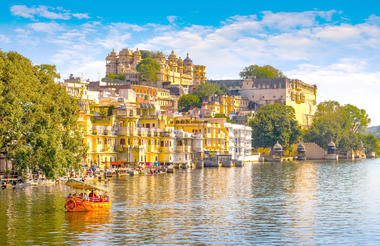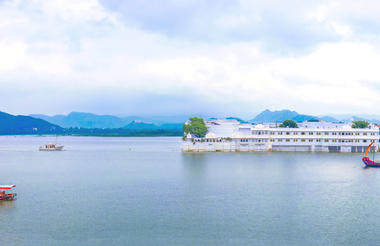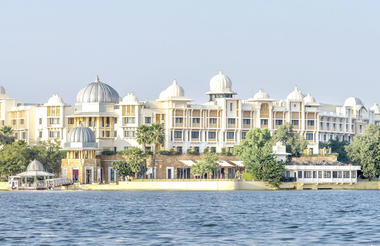India’s capital, New Delhi, lies on the Indo-Gangetic Plain, within the National Capital Territory of Delhi. Made up of the ancient walled city of Old Delhi and the more modern sector, New Delhi, the city encompasses a staggering array of beautiful buildings, including three UNESCO World Heritage Sites – the grand, sandstone Red Fort, striking Qutab Minar, and fascinating Humayun's Tomb. Architecture enthusiasts will delight in the iconic Lotus Temple. Hear ‘qawwalis’ (devotional music) at the dargah (tomb) of the Sufi saint Nizam-ud-din Auliya; or wander through the 17th century Chandni Chowk marketplace – still one of the city’s most popular retail centres today, famous for its traditional jewellery and saris. The gorgeous Sunder Nursery and Lodi Garden provide calm, flower-filled oases for picnicking.
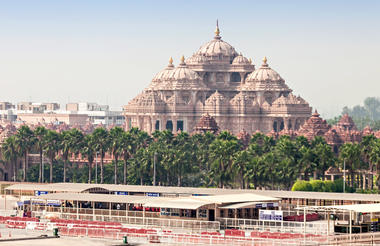

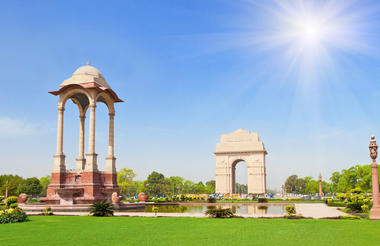
Set on the banks of the Yamuna River in Uttar Pradesh, Agra is a beautiful city famous for its incredible Taj Mahal building, one of the seven wonders of the world. Commissioned by the Mughal emperor Shah Jahan in the 15th century as a memorial to his beloved wife Mumtaz Mahal, this is an architectural masterpiece of exquisite craftsmanship and perfect proportions. The city boasts numerous other superb attractions, including the red-hued sandstone Agra Fort, built in the 16th century; the Shahi Jama Masjid mosque, a 17th-century congregational mosque located in the historic core of Agra, and Itmad-ud-Daulah’s tomb, with its white marble facade embellished with intricate inlaid designs, also called the' Baby Taj'.



Fringed by the rugged Aravali Hills, Jaipur, nicknamed the ‘Pink City’ for its salmon-hued terracotta buildings, is the capital and largest city in the Rajasthan State. This metropolis combines tradition and modernity with its vibrant bazaars, lavish palaces, and ancient temples. Don’t miss the fairy-tale splendour of the Amber Fort, set against the backdrop of the arid landscape and hosting enthralling sound and light shows; the UNESCO-listed Jantar Mantar, a collection of 300-year-old astronomical tools which look like contemporary art; and the opulent City Palace, with its palatial structures, sprawling gardens, and atmospheric courtyards. Jaipur falls within the Golden Triangle, a popular tourist circuit, which includes Delhi, Jaipur, and Agra, and it also serves as a gateway to the neighbouring desert cities of Jaisalmer and Jodhpur.
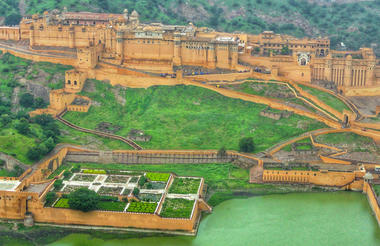
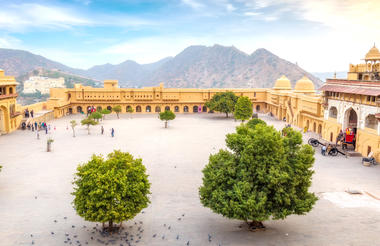
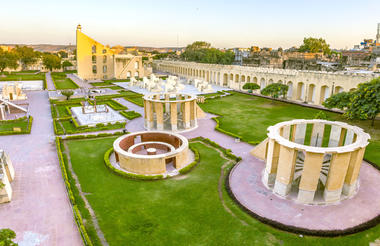
Located in the Shekhawati region of the Jhunjhunu district, the town of Mandawa is known as the "Open-air Art Gallery" of Rajasthan, India. Originally a trading post for rich merchants, Mandawa has recently flourished into a popular tourist destination offering visitors a collection of historic mansions, palaces and forts which feature elaborate frescoes and intricate architecture. This relatively small yet bustling town is a treasure trove for art collectors who can hunt through the quaint medieval bazaars for traditional handmade relics. The most visited attraction is undoubtedly the 18th-century Mandawa fort, recently converted into a heritage hotel, which showcases exquisite murals, paintings and mosaic work. Don’t miss the spectacular Jhunjhunwala Haveli mansion which boasts an impressive gold leaf-painted room.
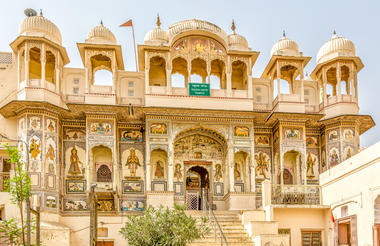
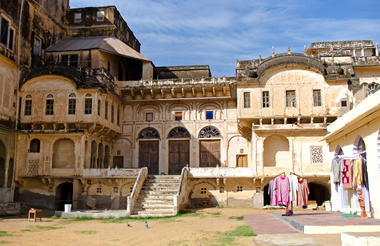
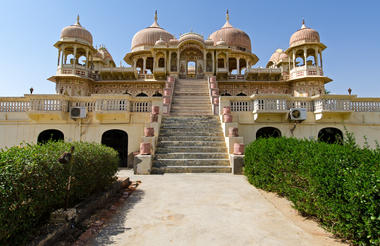
One of the most loved snack exports out of India has its origins in this Rajhastani city. Bikaneri Bhujia, an Indian version of potato chips, has become popular across the globe and today the crispy snack, using gram flour and spices, provides employment to over 2.5 million people. Bikaner boasts many unique architectural features such as the Bikaner Havelis – manifold mansions lining the narrow lanes of old town, signalling a glorious and opulent heyday in Bikaner history – and the beautiful Junagarh Fort, with its tall ochre walls extending for almost a kilometre around the impressive structure.

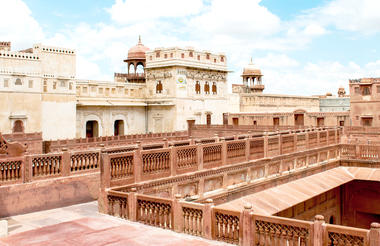

Situated amid the vast expanse of the Thar Desert on the far western border of India’s Rajasthan state, the city of Jaisalmer is home to the world's only inhabited medieval living fort. This 12th-century city served as a bustling trading post along the famous Silk Road and still to this day features markets selling silk, cashmere, silver jewellery, bronze statues and much more. The undeniable star attraction of this city is the spectacular Jaisalmer Fort, which rises from the desert floor like a gigantic sandcastle and encompasses winding streets filled with shops, temples, hotels and ancient mansions. Visitors can also look forward to taking jeep and camel safaris into the surrounding desert and exploring a variety of grand palaces, elaborate Jain temples and ornate havelis.
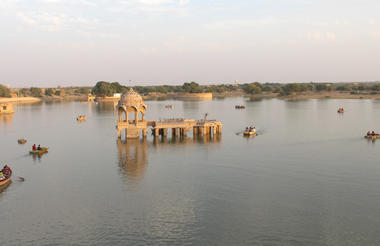

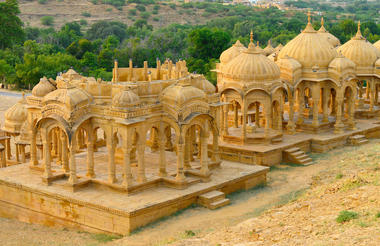
India’s largest state, Rajasthan, is also one of its most captivating. Known for its vibrant cities, the golden splendour of the sprawling Thar Desert, the age-old Aravalli mountain range and countless beautiful palaces, temples and forts – a legacy of its royal Rajput heritage. Highlights include the colourful capital, Jaipur – a veritable shopping mecca; the serene city of Udaipur, with its glittering lakes and mountainous backdrop; the ancient palaces and rosy-hued architecture of Jaipur, dubbed ‘The Pink City’; and forays into the desolate beauty of the Thar Desert’s sun-drenched dunes.



Known as the gateway to the Thar Desert, Jodhpur is the second-largest city in the state of Rajasthan, India. It is a popular tourist destination featuring a variety of ornate palaces, age-old forts, and sacred temples. Dubbed ‘The Blue City’, the old city contains houses in a beautiful shade of indigo. While Jodhpur is largely a sprawling modern metropolis, enclosed within its old city walls is a labyrinth of winding, narrow medieval streets, and bazaars. The massive 15th-century Mehrangarh Fort, which towers over the city from its sandstone plinth, is one of the largest in the country. Other must-see attractions include the Umaid Bhawan Palace, one of the world's largest private residences; and the Jaswant Thada, an intricately carved white marble mausoleum.
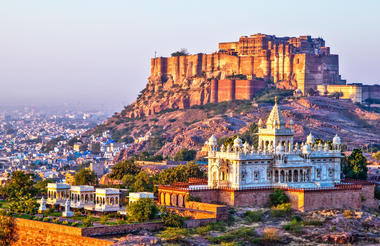
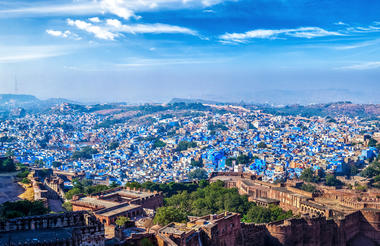
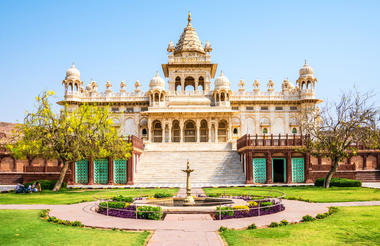
The small town of Ranakpur is home to what is arguably the most spectacular of all India’s Jain temples. The complex rests on a lush mountain slope and encompasses a series of temples dating to the 15th century, all constructed from white marble and featuring exquisite decorative detail. The main temple, Chamukha, is a multi-tiered structure with no less than 80 domes and over 1400 pillars, all of which are intricately carved with unique designs – no two are alike. As the light changes during the day, so does the colour of the temple interior, shifting from golden to cream and then pale blue at dusk. In addition to admiring the temples, sightseers can go trekking in Roopnmata or enjoy a Jeep Safari at the Ranakpur Wildlife Sanctuary. Crocodile-spotting, wolf-spotting at the Jaba Wolf Point and watching a beautiful sunset at the Ranakpur Dam are other activities to indulge in here.



Dubbed the ‘Venice of the East’, the city of Udaipur is built around three interconnected lakes – Lake Pichhola, Fateh Sagar Lake, and the smaller Swaroop Sagar Lake – and is encircled by the hills of the Aravalli mountain range. It is home to an array of ancient temples and fairy-tale-like palaces (several of the latter have been converted into luxury heritage hotels) and is known as one of Rajasthan’s most beautiful and romantic cities. Must-see attractions include the City Palace, the Lake Palace (set on a small island in the middle of Lake Pichola), and the Udaipur Solar Observatory – Asia’s premier solar-gazing site.
